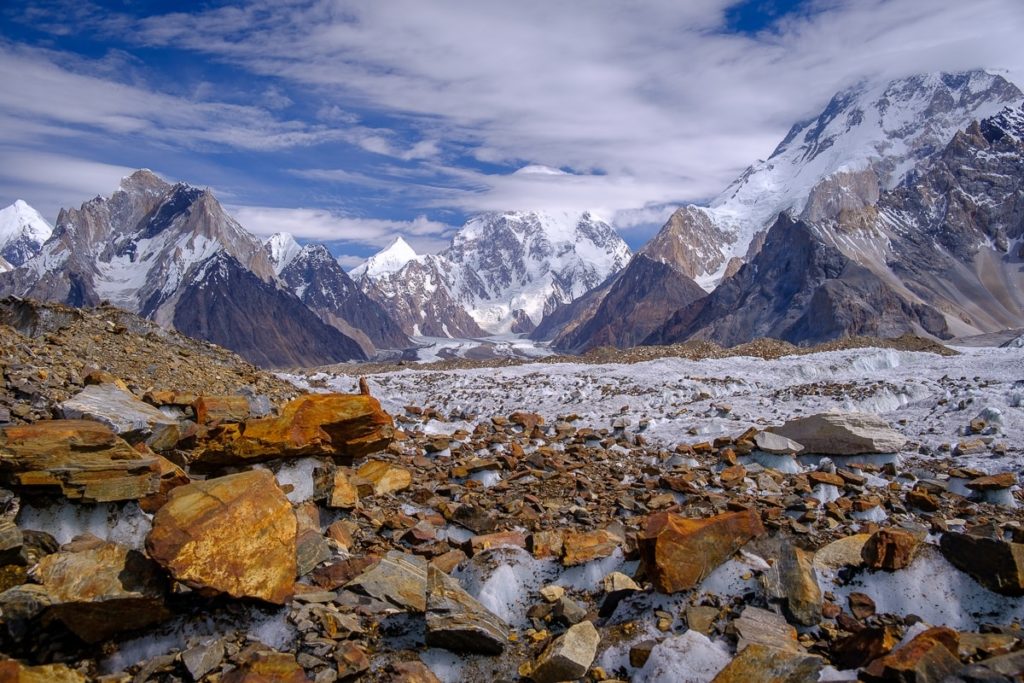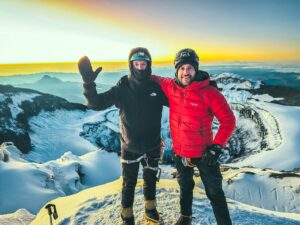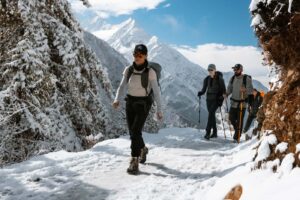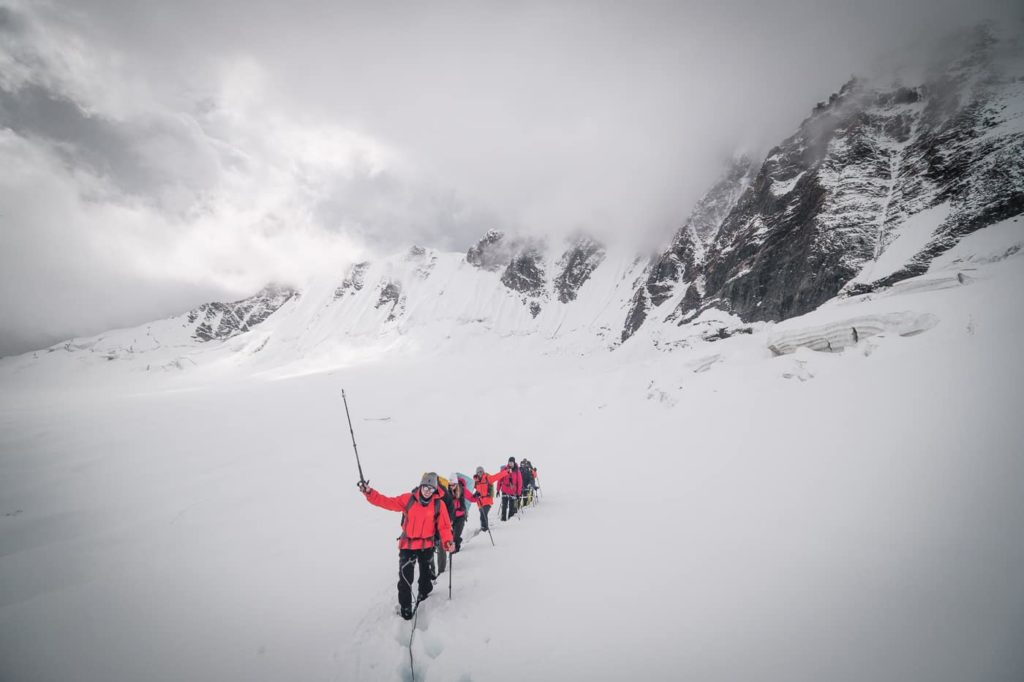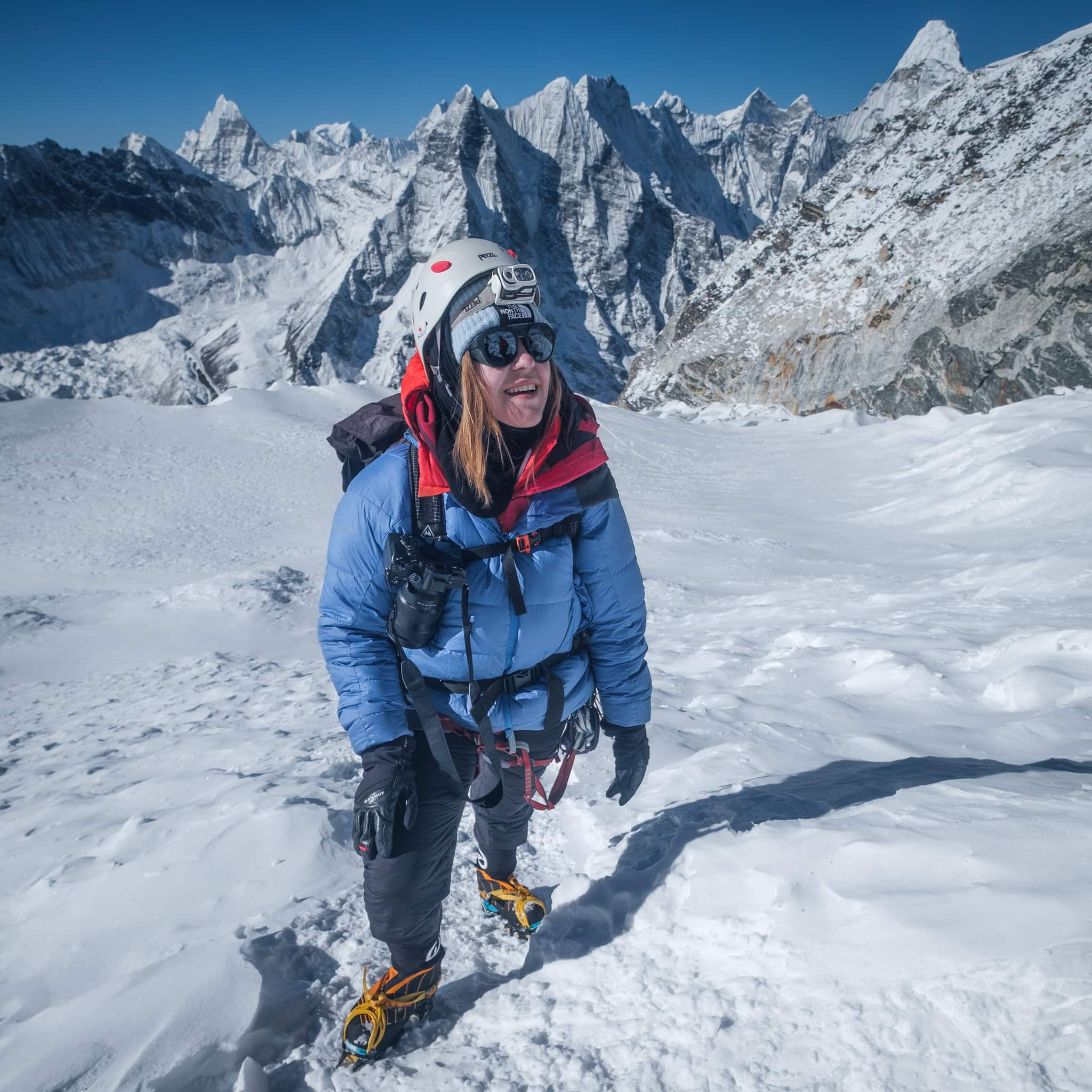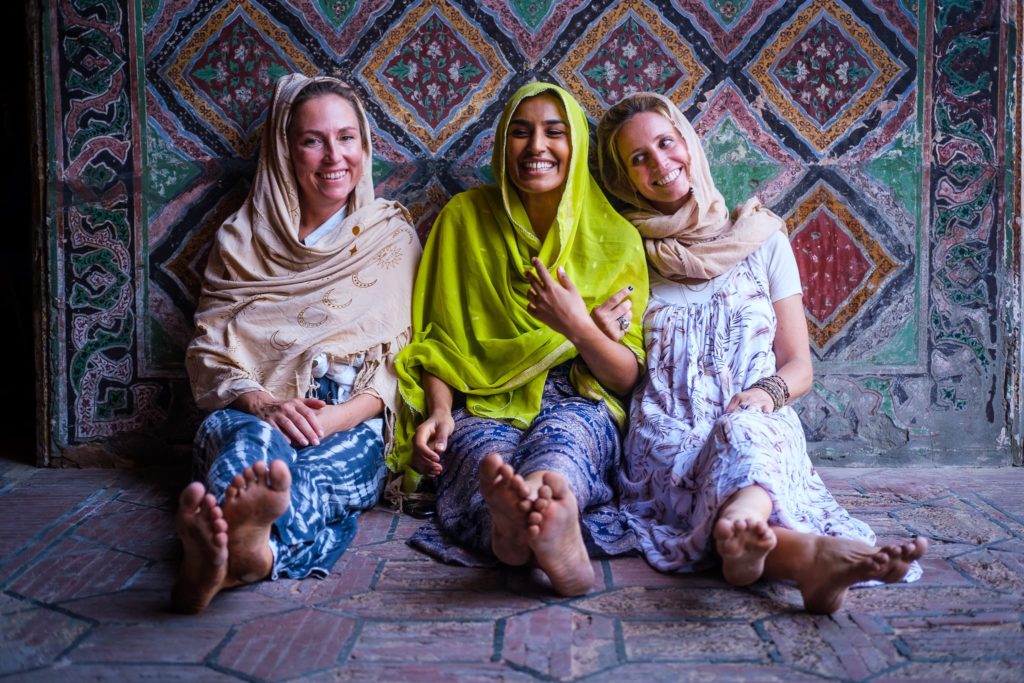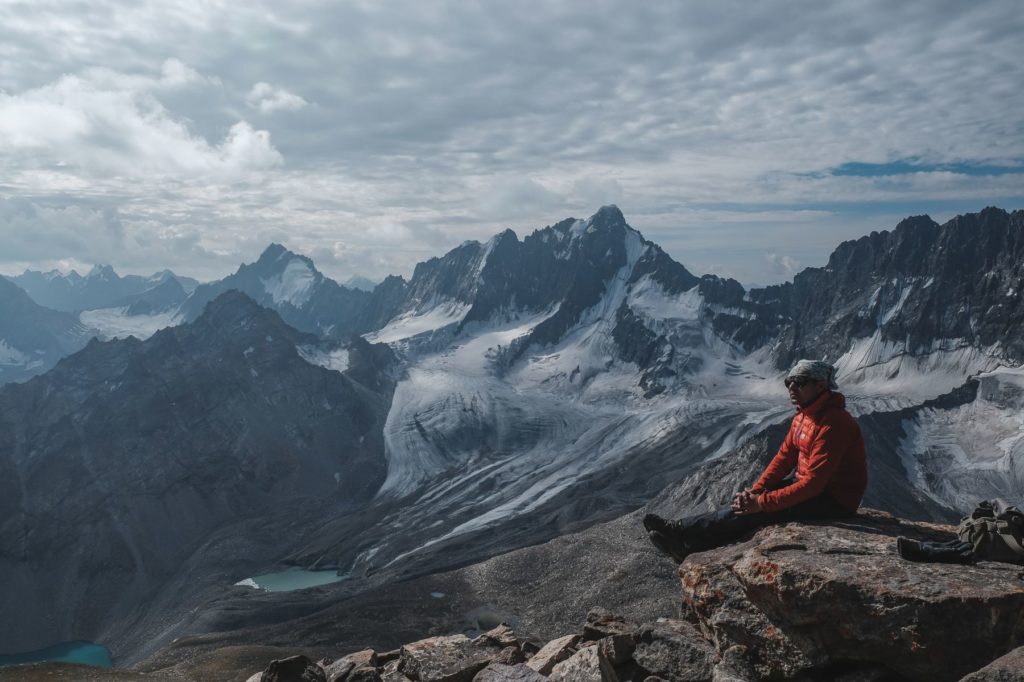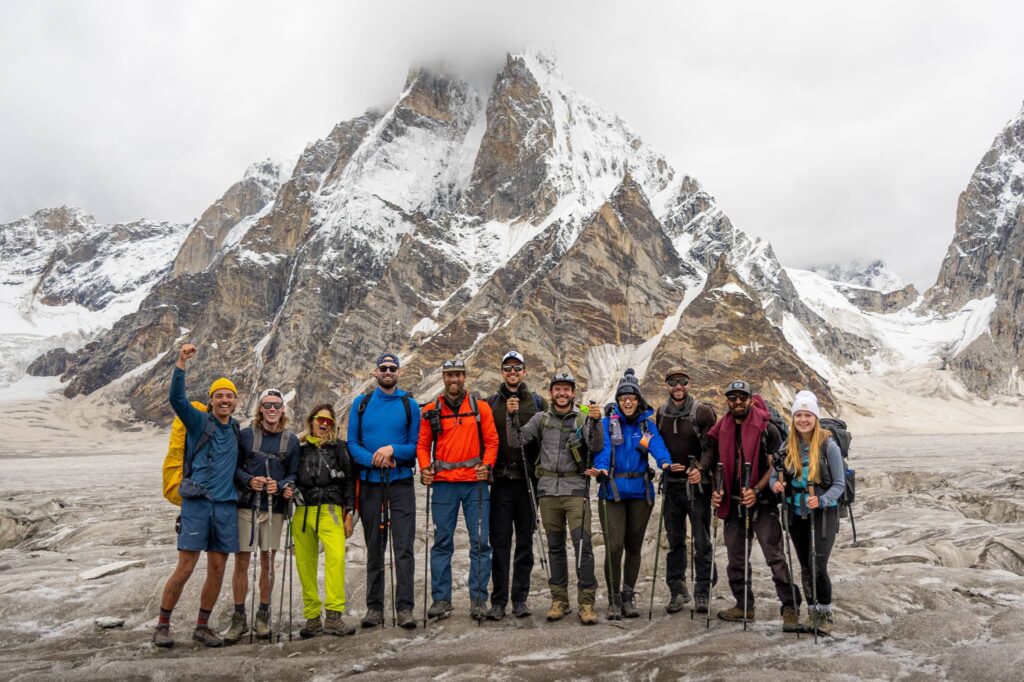Many people travel to Pakistan for the opportunity to undertake a high-altitude trek and see some of the highest mountains in the world.
Of course, like most alpine regions, there is a fair amount of glacier present on these excursions.
Actually, the concentration of glaciers in Pakistans is actually extremely high. If you travel to the northern areas like Baltistan, Hunza, or Chitral, you’re bound to run into a glacier eventually.
The glaciers of Pakistan are truly marvelous to see in person and even more thrilling to cross (when done properly). There’s just nothing else quite like seeing a glacier encroach on a bridge, ready to swallow it, or navigate the mangled jaws of the likes of the Baltoro.
In this week’s article, we’re going to take a closer look at Pakistan’s glaciers and talk about why they’re so significant. You’ll get to know famous glaciers a bit better and will learn what it takes to traverse these icy mammoths. By the end, we hope you will be inspired to visit Pakistan and see its glaciers for yourself.
What makes Pakistan’s glaciers so special?
When some people think of Pakistan, they imagine it as either a) full of crowded, hectic cities or b) desert. Quite literally, it’s something in-between Iran and India.
Little do they know that Pakistan is actually one of the most glaciated countries on the planet.
In fact, there are over 7,000 known glaciers in Pakistan and together these form the most amount of ice outside the polar regions!
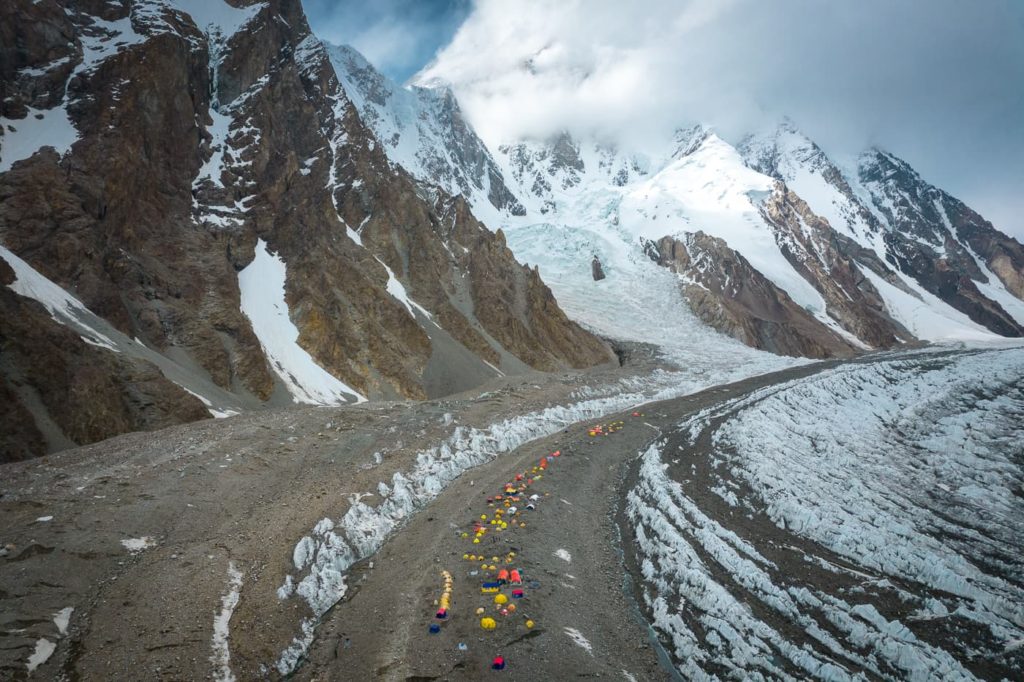
Crisscrossed by the three highest mountain ranges in the world – the Karakoram, Himalaya, and Hindu Kush – Northern Pakistan is totally carved out of ice and rock. The hidden valleys, soaring peaks, and mighty rivers such as the Indus all exist thanks to the glaciers.
The glaciers also provide much-needed irrigation to the local communities and are practically the lifeblood of all civilization in the north. The locals have gotten pretty good at taking advantage of these glaciers, creating intricate systems of canals for watering crops and removing pieces of it for refrigeration. Without the glaciers, there would be no life in the rugged north.
Are Pakistan’s glaciers melting?
Mostly yes, but also no.
For starters, climate change has indeed affected parts of Pakistan in a profound way. Rapidly rising temperatures lead to rapidly melting snow, which then causes massive flooding. Whole villages have been swept away and people frequently drown. Like the rest of the world’s alpine areas, many glaciers in Paksitan are receding.
Conversely, some glaciers in Pakistan appear not to be shrinking. In fact, they appear to be growing. This paradoxical phenomenon has come to be called “The Karakoram Anomaly” by researchers.
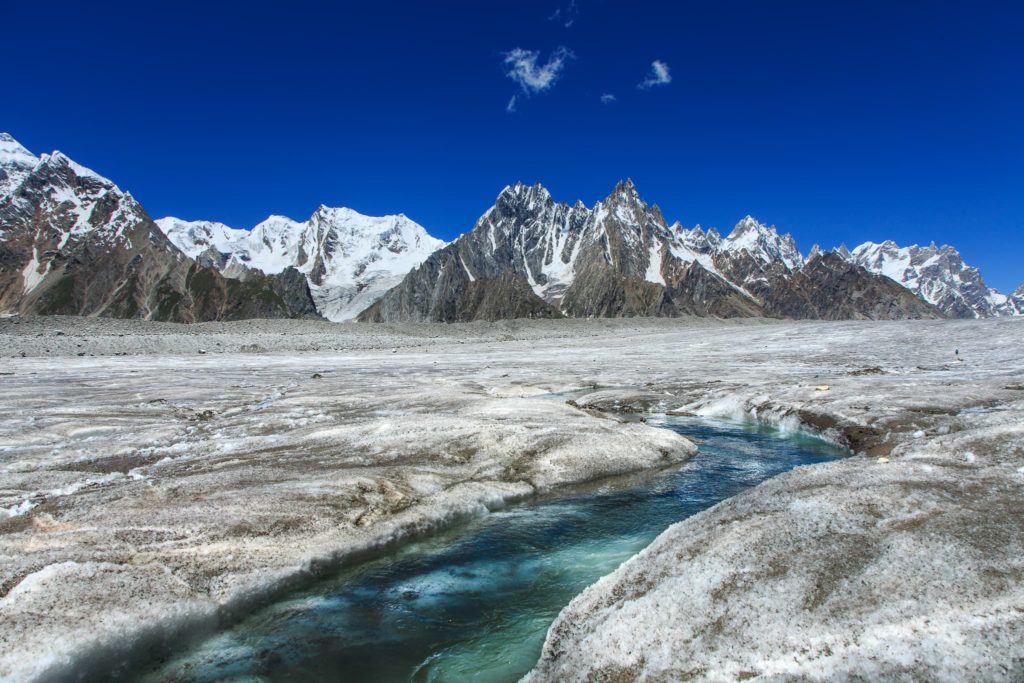
Experts are not sure why or how the anomaly is possible. Many attribute the unusual trend to the ubiquitous rubble covering the glacier, which acts as insulation against rising temperatures. Others say it’s just a poor conclusion drawn from incomplete field data – the Karakoram are, after all, extremely difficult to work in. Ultimately, the Karakoram Anomaly remains just an interesting theory.
Regardless of their apparent stability, the glaciers of Pakistan are still threatened by climate change. They may not be shrinking as noticeably or quickly as the Himalaya, but that’s not saying they’re completely immune either. Time will tell what their actual fate will be.
Notable glaciers in Pakistan
Pakistan hosts over 7000 glaciers! Here are a few that you’ll probably hear about when planning a trip there.
Baltoro Glacier
Length: 39 miles/63 km

The fifth-longest glacier in the world and home to four of the world’s fourteen 8000-meter peaks: K2, Broad Peak, Gasherbrum I, and Gasherbrum II. It is regarded as one of the most awe-inspiring locations known to man and its sheer grandeur has begotten famous nicknames like “The Throne Room of the World”.
From the Baltoro springs dozens of other smaller, yet still impressive glaciers, namely the Trango Glacier, Chogolisa Glacier, and Austin-Goodwin Glacier at the foot of K2.
The Baltoro Glacier is also the setting for the superlative K2 Base Camp Trek. Like a giant ice-laden red carpet (or rather blue), the glacier leads you further and further up until you reach the king itself: K2. Surrounded by some of the world’s highest mountains, navigating the jagged snout of the glacier is a truly once-in-a-lifetime experience.
Biafo Glacier
Length: 42 miles/67 km
Starting in Askole – the same starting point of the Baltoro – and running all the way north to intersect the Hispar Glacier, the Biafo is technically the longest glacier (completely) in Pakistan.
The Biafo Glacier is somewhat similar in topography to the Baltoro, being mostly laden with rubble. Rimming the sides are semi-arid meadows that locals use for cattle grazing. Camping is relatively comfortable.
Though it may not feature such famous giants, like K2, walking up the Biafo is no less stunning. The scenery is just as stunning and even surpasses the Baltoro in some ways. Here, you will get to see the infamously terrifying Latok group, which is considered by many climbers to host some of the most dangerous alpine-style climbs in the world. The stories from here are gnarly.
Hispar Glacier
Length: 30 miles/49 km
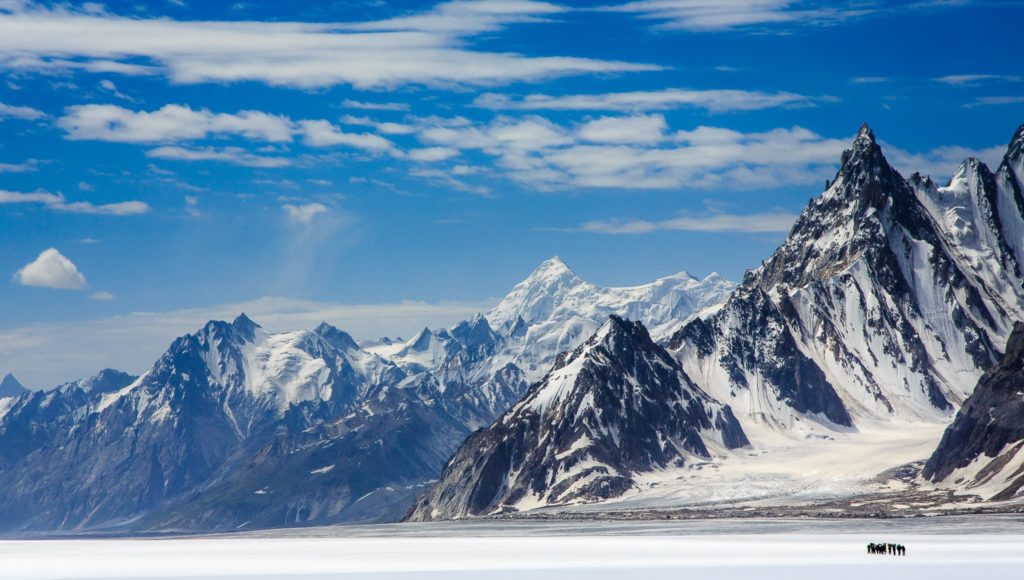
The Hispar and Biafo combine to form not only the longest glacial system outside the polar regions but also one of the greatest treks in the world: Snow Lake.
The Biafo is not like the Baltoro or Biafo Glaciers – it is much icier than the other two, which is why they call it “Snow Lake”. When standing on the glacier, all you’ll see is miles and miles and empty whiteness punctuated by the jagged spires that typify the Karakoram. It is a truly unique and spectacular site, of which the original discoverer, Martin Conway, said:
“Beyond all comparison the finest view of mountains it has ever been my lot to behold.”
But with more ice comes more technical challenges. Trekkers must rope up when crossing the glacier lest they risk falling into one of the many crevasses. After all, this is real glacier as one comes to imagine them.
Siachin Glacier
Length: 47 miles/76 km
“Longest glacier in all of the Karakoram” and “second largest in the world outside of the polar regions” are a few of the Siachin Glacier’s impressive distinctions.
Unfortunately, the distinction that garners the most attention for the Siachin is that it’s often considered “the world’s highest battlefield”. For the last 40 years, the glacier has been disputed territorially by India and Pakistan, and battles have erupted here in the past. As such, the Siachin has become a symbol of animosity between the two warring nations.
It’s a shame too because the Siachin Glacier features some truly magnificent alpine landscapes, comparable to the Baltoro. We’ll just have to wait for Pakistan and India to settle their beef first before visiting – and you’ll know we’ll be the first in line!
Batura Glacier
Length: 35 miles/57 km
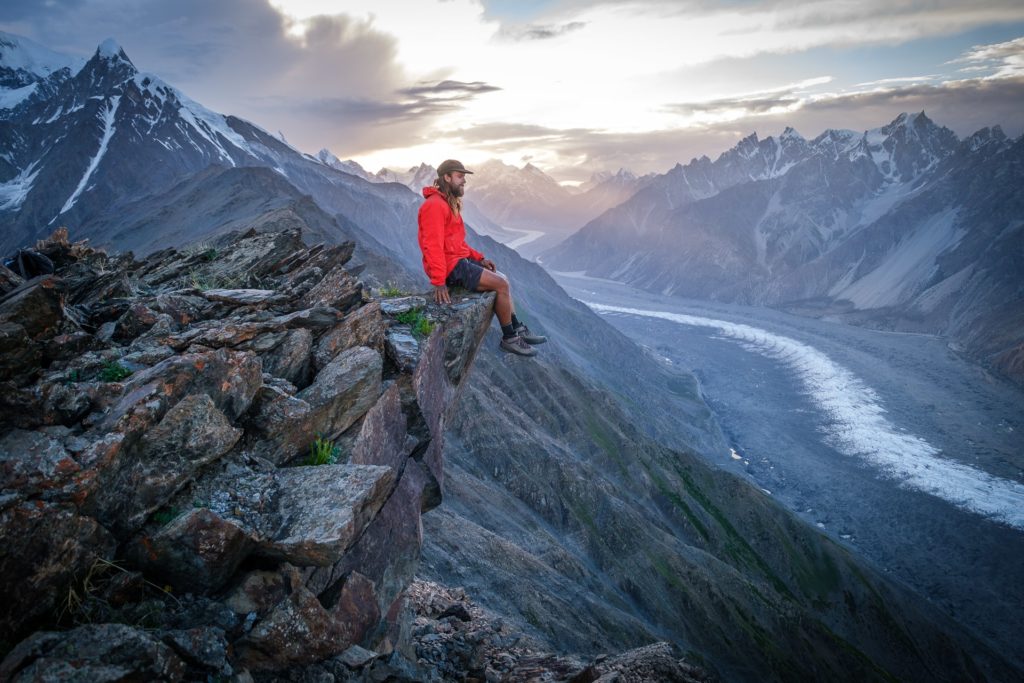
Located in the Hunza Valley, the Batura Glacier is the longest in Pakistan outside of Baltistan. Like the Baltoro and Biafo, this one is a massive traffic jam of rock, ice, and earth.
The Batura is not commonly visited or seen by trekkers, mostly due to the absence of notable peaks or trails in the vicinity. Most settle for seeing more accessible glaciers nearby, like the Passu or Ghulkin Glaciers.
But the Batura Glacier really is impressive, especially when seen from above.
The best views of the Batura Glacier are from the Patundas Meadow, which we visit on our Discover the Hunza Valley itinerary. Straddling both the Batura and Passu Glaciers, you’ll get a bird’s eye view of both from here. The sunsets are particularly incredible.
Tips for crossing the glaciers in Pakistan
Crossing a glacier isn’t like a normal hike – there are some serious factors to consider before undertaking something like this. Here are some tips to help prepare yourself for a trip featuring glacier travel in Pakistan.
Travel with a team
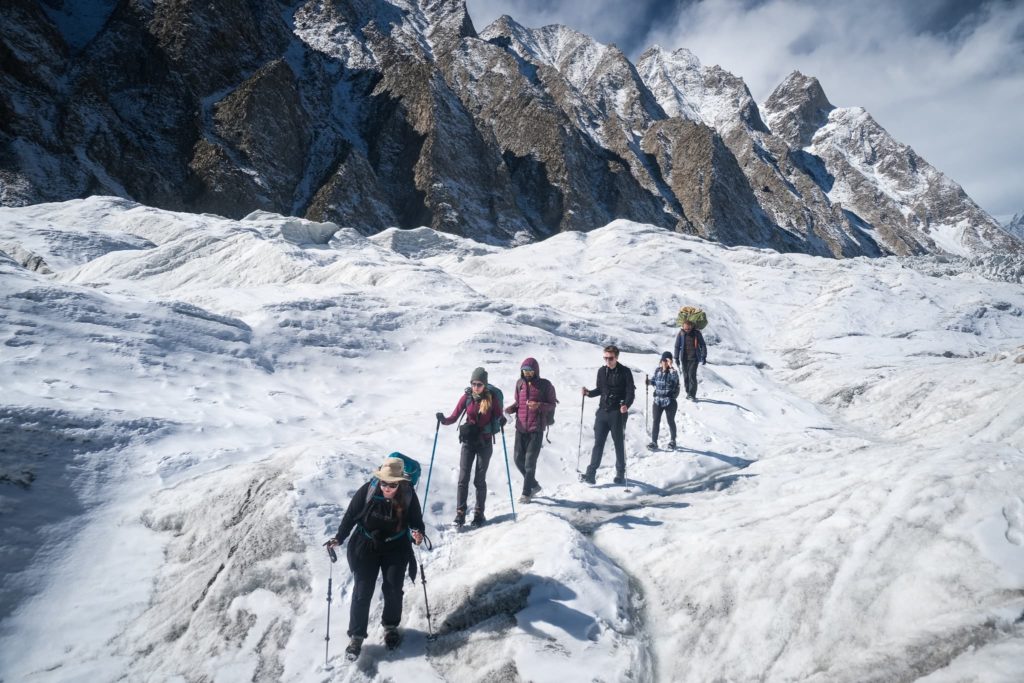
Glacial travel is serious business that often takes several days if not weeks to complete. Journeys of this duration require ample supplies, porters, equipment, and support.
You should not be crossing alone. For one thing, you will need someone to help carry everything as food and gear quickly get heavy. More importantly, you will need someone to watch your back and make sure you don’t end up in a place you shouldn’t, like the bottom of a crevasse. This is why we rope in: to catch each other from falling.
When you join an organized expedition, like the ones Epic Expeditions does, you receive full support. And not just in the form of extra hands and logistics, but also in pre-trip planning and mental preparation. We like to think that there’s more that goes into a tour than just staffing and supply runs, and that you get more out of it than just a good time. Rather, this is a once-in-a-lifetime experience that has the potential to really impact the lives of everyone.
Understand the glacier beforehand
We’ve already mentioned that there are several different types of glacial terrain in Pakistan, the two most common being rubble-strewn (black glaciers) and exposed, icy ones (white glaciers). The grand majority of these are found in valleys.
The way one traverses a glacier will depend a lot on its composition. Glaciers covered in rubble in rock are not usually technically challenging but are still physically demanding. On the other hand, exposed glaciers usually feature more dangerous obstacles, like crevasses, that need to be treated with the utmost caution.
Before attempting to cross a glacier, study its unique topography and formulate a plan. Know what you’re getting yourself into and what you can expect. Never go in blindly.
Have the proper equipment
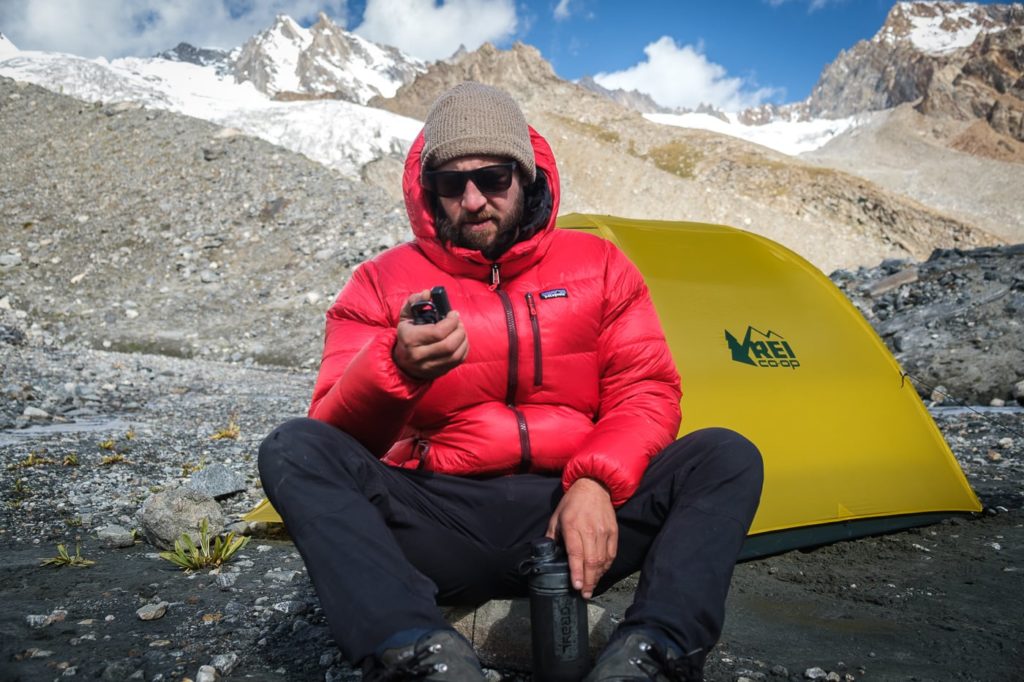
Different terrain requires different gear, and you need to be sure you have the right stuff.
That old, worn-out pair of hiking boots may work on a small, mostly rocky crossing, but will absolutely fail on longer, mixed terrain crossings where ice is involved. At the same time, a light jacket may feel good in the daytime but when the sun goes down you’re going to need something MUCH warmer.
Once you understand the nature of the glacier and its demands, the next step is equipping yourself with the right gear. Having the right layering system, a warm sleeping bag, and reliable safety equipment, among other items, is crucial to a successful expedition.
For some ideas on what to bring, feel free to refer to our recommended packing list for K2 Base Camp.
Give yourself time
Crossing a glacier can be tedious, not to mention exhausting. Navigating endless boulder fields, staying vigilant for crevasses, and keeping an eye out for rock falls: none of these things should be done rushed.
Whatever your average trekking time is, it will probably be a bit lower on the glacier. The going is slow sometimes and you will need to take frequent breaks to recharge. If you go in thinking you’re going to blitz through this terrain, you’re probably going to get equally frustrated and gassed.
For our K2 Base Camp trek program, we opt to start trekking earlier in the day. This allows ample time to reach the next camp without over-exerting ourselves and helps to make an already difficult itinerary a little bit easier.
Cross earlier in the day
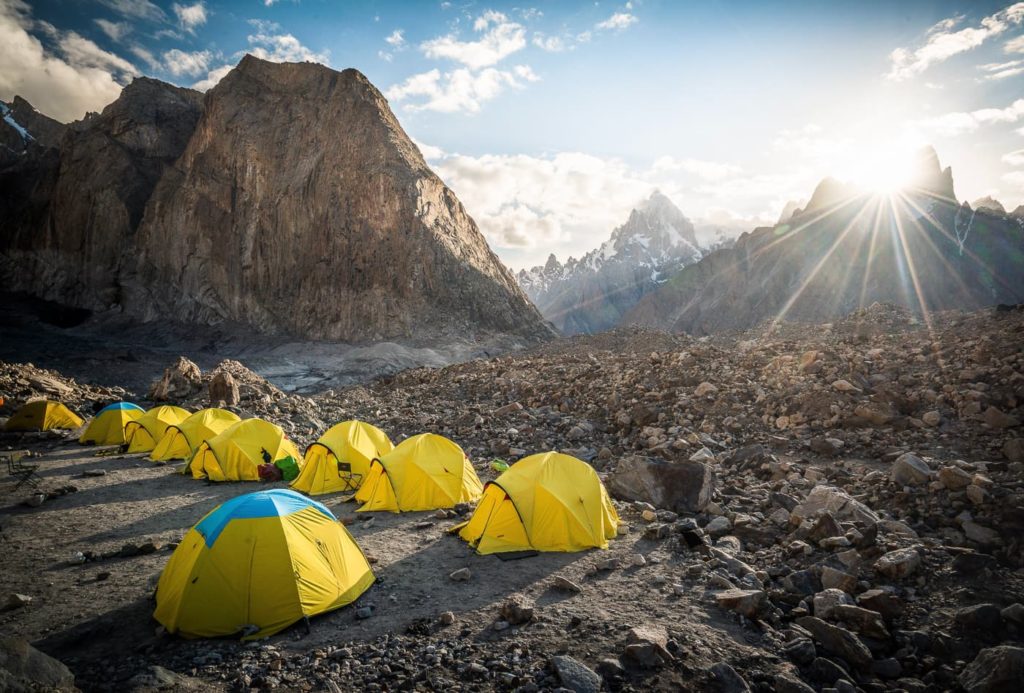
The earlier you start trekking, the better. Mornings are when the temperatures are still fresh and the ice is solid, both of which make for easier hiking.
The longer the day progress, the hotter it becomes – and it can get REAL hot in the Karakoram. By midday, it’s not uncommon to experience temperatures of 30 degrees Celsius and there is little shade to give you respite. Better to be settled in the mess tent around this time.
If there’s lots of snowmelt, waterways will be engorged as well, making the crossing even more difficult. On a hot day in the late afternoon, once timid streams can turn into full-on torrents. Best not to deal with water hazards if you can help it.
Ready to experience the glaciers for yourself?
Join us in Pakistan this year as we visit four out of the five major glaciers mentioned in this article. You can put down a deposit to secure your place on one of our many trips if you are keen to get signed up. Here’s what we offer:
Feel free to contact us for any trip-related questions.

